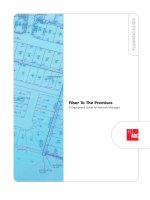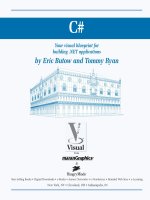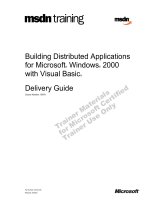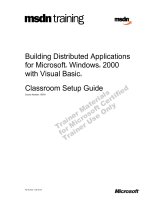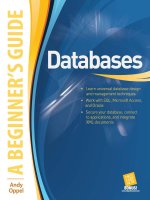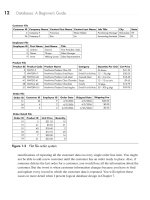building cocoa applications - a step-by-step guide (2002)
Bạn đang xem bản rút gọn của tài liệu. Xem và tải ngay bản đầy đủ của tài liệu tại đây (6.73 MB, 727 trang )
Building Cocoa Applications: A Step-by-Step Guide
By Simson Garfinkel, Michael Mahoney
Publisher: O'Reilly
Pub Date: May 2002
ISBN: 0-596-00235-1
Pages: 648
Copyright
Dedication
Preface
Cocoa and Mac OS X
Organization of This Book
What You Will Need
Conventions Used in This Book
Comments and Questions
Acknowledgments
Part I: Cocoa Overview
Chapter 1. Understanding theAqua Interface
Section 1.1. What Makes Mac OS X So Special?
Section 1.2. A Quick Look at the Mac OS X User Interface
Section 1.3. Basic Principles of the Aqua Interface
Section 1.4. The Mouse and Cursor
Section 1.5. Window Types and Behavior
Section 1.6. Menus and the Menu Bar
Section 1.7. The Dock
Section 1.8. Controls
Section 1.9. The Finder
Section 1.10. Configuring Your Desktop, Step by Step
Section 1.11. Menu Guidelines and Keyboard Equivalents
Section 1.12. Working with the Filesystem,Step by Step
Section 1.13. Summary
Section 1.14. Exercises
Section 1.15. References
Chapter 2. Tools for Developing Cocoa Applications
Section 2.1. Developer Tools
Section 2.2. Utilities
Section 2.3. Working with the Terminal
Section 2.4. Debugging Programs with gdb
Section 2.5. User Interface Design
Section 2.6. Summary
Section 2.7. Exercises
Chapter 3. Creating a Simple Application with Interface Builder
Section 3.1. Getting Started with Interface Builder
Section 3.2. Adding Objects to Your Application
Section 3.3. Objects, Messages, and Targets
Section 3.4. Summary
Section 3.5. Exercise
Chapter 4. An Objective-C ApplicationWithout Interface Builder
Section 4.1. The Tiny.m Program
Section 4.2. An Introduction to Objective-C
Section 4.3. Tiny.m Revisited
Section 4.4. Summary
Section 4.5. Exercises
Section 4.6. References
Part II: Calculator: Building a Simple Application
Chapter 5. Building a Project: A Four-Function Calculator
Section 5.1. Getting Started: Building the Calculator Project
Section 5.2. Building the Calculator's User Interface
Section 5.3. Building the Calculator's Controller Class
Section 5.4. Customizing Buttons and Making Connections
Section 5.5. Compiling and Running a Program
Section 5.6. Compiler Error Messages
Section 5.7. The enterDigit: Action Method
Section 5.8. Adding the Four Calculator Functions
Section 5.9. Adding the Unary Minus Function to the Controller Class
Section 5.10. The Files in a Project
Section 5.11. Summary
Section 5.12. Exercises
Chapter 6. Nibs and Icons
Section 6.1. Customizing MainMenu.nib
Section 6.2. Managing Multiple Nibs
Section 6.3. Adding Icons to Applications
Section 6.4. Changing Calculator's Application Icon
Section 6.5. Cocoa's NSImage Class
Section 6.6. Summary
Section 6.7. Exercises
Section 6.8. References
Chapter 7. Delegation and Resizing
Section 7.1. Handling Different Bases
Section 7.2. Delegation
Section 7.3. Disabling Buttons for BetterMultiradix Input
Section 7.4. Resizing Windows Programmatically
Section 7.5. Two Very Important Classes: NSWindow and NSView
Section 7.6. Summary
Section 7.7. Exercises
Chapter 8. Events and Responders
Section 8.1. Events and the NSResponder Chain
Section 8.2. Events and the NSApplication Object
Section 8.3. The Event Loop
Section 8.4. Catching Keyboard Eventsfor Our Calculator
Section 8.5. Summary
Section 8.6. Exercises
Section 8.7. References
Chapter 9. Darwin and the Window Server
Section 9.1. Unix, Mach, and the Mac OS X Environment
Section 9.2. The Window Server and Quartz
Section 9.3. Seeing All the Processes
Section 9.4. Summary
Section 9.5. Exercises
Section 9.6. References
Part III: MathPaper: A Multiple-Document, Multiprocess Application
Chapter 10. MathPaper and Cocoa'sDocument-Based Architecture
Section 10.1. The MathPaper Application
Section 10.2. The Evaluator Back End
Section 10.3. Cocoa's Document-Based Architecture
Section 10.4. Building MathPaper's Front End
Section 10.5. Summary
Section 10.6. Exercises
Section 10.7. References
Chapter 11. Tasks, Pipes, and NSTextView
Section 11.1. Processes, Pipes, and Resources
Section 11.2. Making Evaluator a MathPaper Auxiliary Executable
Section 11.3. MathDocument Class Modifications
Section 11.4. Creating PaperController, a Subclass of NSWindowController
Section 11.5. The NSScrollView and NSTextView Classes
Section 11.6. PaperController Class Modifications
Section 11.7. Summary
Section 11.8. Exercises
Chapter 12. Rich Text Format and NSText
Section 12.1. Rich Text Format
Section 12.2. Creating an RTF Class
Section 12.3. Integrating Our RTF Class into MathPaper
Section 12.4. Summary
Section 12.5. Exercises
Chapter 13. Saving, Loading, and Printing
Section 13.1. Data Management with NSDocument
Section 13.2. Saving to a File
Section 13.3. Loading from a File
Section 13.4. Marking a Document Window as Edited
Section 13.5. Adding Printing Capability
Section 13.6. Summary
Section 13.7. Exercises
Chapter 14. Drawing with Quartz
Section 14.1. Animation in an About Panel
Section 14.2. The Quartz Window Server
Section 14.3. Implementing the About Panel in MathPaper
Section 14.4. Quartz Graphics Data Types
Section 14.5. Timers
Section 14.6. Putting It All Together
Section 14.7. Summary
Section 14.8. Exercises
Section 14.9. References
Chapter 15. Drawing in a Rectangle: More Fun with Cocoa Views
Section 15.1. The Advantages of NSView's drawRect: Method
Section 15.2. BlackView: An NSView That Paints Itself Black
Section 15.3. A Closer Look at the NSView Class
Section 15.4. BarView: An NSView with a Scaled Coordinate System
Section 15.5. PolygonView: A Non-Opaque NSView
Section 15.6. Responding to Events in an NSView
Section 15.7. Autosizing Multiple Views in a Window
Section 15.8. Summary
Section 15.9. Exercises
Part IV: GraphPaper: A Multithreaded, Mouse-Tracking Application
Chapter 16. GraphPaper: A Multithreaded Application with a Display List
Section 16.1. GraphPaper's Design
Section 16.2. Working with Multiple Threads
Section 16.3. Building the GraphPaper Application
Section 16.4. Extending the Display List
Section 16.5. Summary
Section 16.6. Exercises
Section 16.7. References
Chapter 17. Color
Section 17.1. Colors and Color Objects
Section 17.2. Adding Color to GraphPaper
Section 17.3. Summary
Section 17.4. Exercises
Chapter 18. Tracking the Mouse
Section 18.1. Tracking the Mouse
Section 18.2. Adding Mouse Tracking to GraphPaper
Section 18.3. Summary
Section 18.4. Exercises
Section 18.5. References
Chapter 19. Zooming and Saving Graphics Files
Section 19.1. Adding a Zoom Button to GraphPaper
Section 19.2. Saving to PDF
Section 19.3. Saving to TIFF
Section 19.4. Creating an Accessory NSView
Section 19.5. Summary
Section 19.6. Exercises
Chapter 20. Pasteboards, Services, Modal Sessions, and Drag-and-Drop
Section 20.1. Cut, Copy, and Paste with the Pasteboard
Section 20.2. Using the Pasteboard in GraphPaper
Section 20.3. Services
Section 20.4. Creating Your Own Service
Section 20.5. Drag-and-Drop
Section 20.6. Summary
Section 20.7. Exercises
Chapter 21. Preferences and Defaults
Section 21.1. Preferences and the Defaults Database System
Section 21.2. Adding Defaults to GraphPaper
Section 21.3. Making the Preferences Panel Work with Defaults
Section 21.4. Setting Up a Multi-View Panel
Section 21.5. Summary
Section 21.6. Exercises
Appendix A. Cocoa Resources
Section A.1. Apple Resources
Section A.2. Third-Party Resources
Colophon
Book: Building Cocoa Applications: A Step-by-Step Guide
Copyright © 2002 O'Reilly & Associates, Inc. All rights reserved.
Printed in the United States of America.
Published by O'Reilly & Associates, Inc., 1005 Gravenstein Highway North, Sebastopol,
CA 95472.
O'Reilly & Associates books may be purchased for educational, business, or sales
promotional use. Online editions are also available for most titles (illy.
com). For more information contact our corporate/institutional sales department: 800-998-
9938 or
Nutshell Handbook, the Nutshell Handbook logo, and the O'Reilly logo are registered
trademarks of O'Reilly & Associates, Inc. Many of the designations used by manufacturers
and sellers to distinguish their products are claimed as trademarks. Where those
designations appear in this book, and O'Reilly & Associates, Inc. was aware of a trademark
claim, the designations have been printed in caps or initial caps. The association between
the image of a Mastiff and building Cocoa applications is a trademark of O'Reilly &
Associates, Inc.
Apple Computer, Inc. boldly combined open source technologies with its own
programming efforts to create Mac OS X, one of the most versatile and stable operating
systems now available. In the same spirit, Apple has joined forces with O'Reilly &
Associates, Inc. to bring you an indispensable collection of technical publications. The
ADC logo indicates that the book has been technically reviewed by Apple engineers and is
recommended by the Apple Developer Connection.
Apple, the Apple logo, AppleScript, AppleTalk, AppleWorks, Cocoa, Finder, Mac,
Macintosh, MPW, QuickDraw, QuickTime, and Sherlock are trademarks of Apple
Computer, Inc., registered in the United States and other countries. Aqua, Carbon, and
Quartz are trademarks of Apple Computer, Inc.
While every precaution has been taken in the preparation of this book, the publisher and
the author assume no responsibility for errors or omissions, or for damages resulting from
the use of the information contained herein.
Book: Building Cocoa Applications: A Step-by-Step Guide
Dedication
For the kids: Nina, Timmy, Sonia, Jared, and Draken
Book: Building Cocoa Applications: A Step-by-Step Guide
Preface
Welcome!
Building Cocoa Applications describes how to write Objective-C programs for computers
running the Mac OS X operating system, using the object-oriented Cocoa application
framework. The book covers a wide range of technologies:
● The Aqua graphical user interface, Cocoa developer tools, object-oriented concepts,
and the Objective-C language
● Cocoa programming and graphics concepts: nibs, icons, delegation, resizing,
events, responders, tasks, pipes, color, Rich Text, the mouse, zoom buttons,
pasteboards, modal sessions, and drag-and-drop
● The Cocoa environment: Darwin and the Window Server, the document-based
architecture, the Quartz drawing system, Cocoa's preferences and defaults systems,
and facilities for saving, loading, and printing
Building Cocoa Applications is a no-nonsense, hands-on book that's intended for serious
developers. It's filled with extended examples illustrating complete applications written in
Objective-C. As you proceed through the book, you'll take a step-by-step approach to
building a series of applications of increasing complexity, adding features as you go.
Although we do not assume prior knowledge of the Macintosh or any other window-based
operating environment, we do assume some familiarity with programming in general and
the ANSI C language in particular.
Our primary goal is to get you up and running as quickly as possible. If you carefully read
this book from cover to cover and diligently build the sample applications along with us,
we're confident that you'll soon be writing your own sophisticated Cocoa graphics
applications.
While this book is fast moving, we start by laying a solid foundation. Part I of the book
explains how to use Aqua, the Mac OS X graphical user interface (GUI), and describes the
Cocoa developer tools you'll use to build applications. It also introduces two simple but
complete Cocoa applications - one built with Cocoa's Interface Builder tool and one built
without it. Parts II, III, and IV are organized by application: we'll build three major, highly
useful graphics applications and, in doing so, teach you how to build your own applications
with Cocoa. The applications we will build are:
Calculator (Part II)
A simple, four-function calculation application that's similar to the calculator that
comes with Mac OS X
MathPaper (Part III)
An application that is similar to a word processor but that solves equations you
supply
GraphPaper (Part IV)
A more complex, multithreading application that graphs a formula in two
dimensions
The first chapter in each of these three parts introduces the application and builds its most
basic functionality. Each subsequent chapter adds a new layer of functionality. For
example, Chapter 6 shows how to add an icon to the Calculator application so it will
display nicely in the Finder, Chapter 12 enhances MathPaper so it displays Rich Text, and
Chapter 19 adds zoom buttons to GraphPaper.
We'll also build numerous additional simple applications throughout the book to
demonstrate specific features of Cocoa and Mac OS X. You can build all of these
applications right along with us - we provide simple but complete instructions on how to do
whatever is necessary. Code for all of the applications we'll build is provided on the
O'Reilly web site (see Section P.5, later in this Preface).
Book: Building Cocoa Applications: A Step-by-Step Guide
Section: Preface
Cocoa and Mac OS X
Cocoa is an object-oriented development environment that runs in the Mac OS X
environment. Cocoa software has previously been bundled with the Mac OS X user system
on a separate developer CD-ROM, but newer systems come with a package that users can
install - the package name is Developer.mpkg, and it's found in /Applications/
Installers/Developer Tools. Although there are many ways to write programs
for Mac OS X, we think you'll find Cocoa is both the easiest and the most powerful.
Mac OS X and Cocoa Components
From the user's point of view, Mac OS X is a unified operating system and graphical
operating environment that makes computers easy to use. It includes:
Aqua
Apple's revolutionary GUI, which is both visually pleasing and very easy to use.
Quartz
A comprehensive two-dimensional drawing system that can be used to display text
and graphics on a computer screen or on a printer and to create Adobe Portable
Document Format (PDF) files.
The Finder
A graphical interface to the computer's filesystem and to running applications.
Mail, TextEdit, Terminal, Console
Some of the Apple-supplied applications included in Mac OS X.
Foundation
An underlying set of operating-system services that are provided to Carbon, Cocoa,
and Java programs.
System Preferences and the defaults system
Enable users to store their preferences for individual programs without having to
directly modify special files stored in their home directories.
The HFS+ filesystem and UFS filesystem
Organize the way that files and folders are stored on the computer's disks.
TCP/IP networking
Allows Macintosh computers to communicate with each other and with the
Internet.
Darwin
The underlying Unix operating system on which Mac OS X is based.
Figure P-1 shows the relationship between these technologies in the Mac OS X operating
system.
Figure P-1. The Mac OS X architecture
The Mac OS X operating system can run programs with many different kinds of user
interfaces, including:
● Programs written with the Cocoa development environment. These programs
display natively with the Aqua user interface.
● Programs that use a restricted part of the Mac OS 9 interface called Carbon. These
programs also display with the Aqua user interface.
● Programs written in the Java programming language. Java programs can use either
the Cocoa or Swing application frameworks.
● Programs written for the Mac OS 7, 8, and 9 operating systems. These programs
are run in the Mac OS X "Classic" environment and appear as they would on a
Macintosh computer running Mac OS 9.
● Programs written for the underlying Unix operating system. These programs either
do not display a user interface at all, or implement a character-based interface from
the Unix command line.
This book focuses on the Cocoa development environment, but we will mention the other
user interfaces as necessary. From the programmer's point of view, Cocoa includes two
distinct frameworks:
Foundation
A collection of Objective-C classes for managing memory, interfacing with the
computer's operating system, and performing other functions that are independent
of the GUI.
Application Kit (AppKit)
A collection of Objective-C classes that give Cocoa its distinctive look and feel.
By using Cocoa, your programs automatically get the Aqua look and feel. Although every
application is different, Cocoa makes it easier for all applications to work in similar ways,
which in turn makes it easier for people to learn new applications.
Cocoa also makes it easier for applications to work with each other. Because of Cocoa's
object-oriented nature, Cocoa applications can easily provide services and special functions
to other applications running on the same computer or across the network.
Using Cocoa speeds your development time. Programmers with just a few months of
experience with Cocoa report that they can develop a Cocoa application 3 to 10 times faster
using the Foundation and Application Kit than they can using other application frameworks
such as PowerPlant, Qt, or Microsoft's Foundation Classes. For many corporations, this
improved productivity justifies the decision to deploy Macintosh computer systems.
Object-Oriented Programming
Writing programs for Cocoa is similar to, and yet significantly different from, writing
programs for other environments. As with other modern application development
environments, you write Cocoa programs by building systems of related but distinct parts,
or objects, and connecting them together to form an integrated whole. Confining different
aspects of a program to different pieces makes those pieces easier to design, implement,
debug, and reuse. This is what is known as object-oriented programming (OOP).
Unlike development systems based on the C++ programming language (such as Microsoft's
Foundation Classes and Code Warrior's PowerPlant), however, Cocoa is built on top of the
Objective-C programming language. As we shall see, Objective-C is a simpler and more
powerful object-oriented extension of the C programming language than C++.
Cocoa embodies the principles of object-oriented programming from its user interface
down to its very core. This greatly simplifies the task of building applications for Mac OS
X. The down side is that it makes the Cocoa environment very different from the
environments to which most programmers are accustomed, and consequently, although it is
an easy-to-program environment, the initial learning curve is quite steep.
The Roots of Cocoa
Cocoa is a relatively new offering from Apple, but the underlying operating
system on which Cocoa is based is more than a decade old. Although today
Cocoa is an integral part of Mac OS X, much of the Cocoa application
framework dates back to the NeXTSTEP operating system (and subsequently the
OpenStep system) developed by NeXT Computer, Inc., during the late 1980s-
mid 1990s. When Apple bought NeXT in 1996, it also bought the right to use the
software created by NeXT. The fact that Mac OS X is based on such a solid and
long-lived operating system is very important: Cocoa is not some new fad
technology that Apple is trying out today but might soon discard; it is a mature,
time-tested development environment that has been used and improved by many
thousands of programmers over the course of more than a decade.
Cocoa Versions
All the examples in this book were developed and tested under Mac OS X Version 10.1.
Although future versions of Cocoa are sure to add new features and visually change some
of the user interfaces, Objective-C's dynamic binding all but assures that any Cocoa
program developed under Version 10.1 will continue to run on future versions of the
Macintosh operating system. Furthermore, we've tried to focus the subject matter of this
book mainly on the underlying concepts and features of the operating system - and many of
these haven't changed much since the initial release of NeXTSTEP 1.0 in 1989. For these
reasons, this book is likely to stay in print, and be very useful, for quite some time after it is
published.
Cocoa, Objective-C, and Java
Although the Cocoa Foundation and the Application Kit are written in Objective-C, Cocoa
programs can be written in either Objective-C or Java. This freedom comes from the fact
that Java and Objective-C have very similar models of object-oriented programming,
which has allowed Apple to create a "Java bridge" that allows Java objects to invoke
Objective-C methods and vice versa. Java can even be used to subclass Objective-C
classes!
Despite the ability to intermix Objective-C and Java within a single program, this book
focuses solely on the Objective-C programming language. Objective-C is the native
environment of the Foundation and the Application Kit, and it is generally easier to debug
Cocoa programs written in Objective-C than to debug the same programs written in Java.
Furthermore, there are performance considerations: Cocoa-based programs run faster if
they are written in Objective-C than if they are written in Java.
One significant advantage of Java over Objective-C is the large number of third-party class
libraries that are now available for Java. If you need to use one of these libraries, you can
benefit from using Java for some or all of your Cocoa applications. In particular, Apple's
Enterprise Objects Framework now supports only the Java-based application programming
interface (API).
One of the primary differences between Java and Objective-C is memory management:
Java has automatic garbage collection, whereas Objective-C has a reference-count-based
memory-management system. The Objective-C system is cruder, but it gives programmers
greater control and generally produces applications that run faster.
For detailed information on programming Cocoa applications in Java, see the upcoming
O'Reilly book Cocoa and Java. (And for those interested in writing Perl applications for
this new platform, watch for Programming Cocoa Applications with Perl, also coming
soon from O'Reilly.)
The Foundation Classes
Many of the Cocoa class libraries are actually implemented with the Apple Foundation
library. The Foundation provides a series of highly efficient, low-level services for building
advanced applications. Built into the Foundation is support for Unicode strings, XML
property lists, URL resources, preferences, and other key Mac OS X technologies.
The Foundation library is used by both Cocoa and Carbon, and it provides for improved
compatibility between applications written with these two application frameworks.
You can find out more about Foundation by reading the documentation that comes with the
developer tools (it is installed in /Developer/Documentation/
CoreFoundation). For the latest updates, check out the version at:
/>FoundationTOC.html
Drawing with Quartz
One of the most important differences between Mac OS 9 and Mac OS X is the way these
systems draw on the computer's screen. Mac OS 9 does all of its drawing with Apple's
QuickDraw APIs. Mac OS X, in contrast, does its drawing with Quartz.
Quartz integrates into the Macintosh operating system many advanced features that were
previously available only in Apple's QuickDraw GX and NeXT's Display PostScript
drawing environments. Quartz also brings native support for Adobe's PDF. Programs
written for Quartz can display PDF files as a native file type. They can also capture their
drawing commands and generate PDF files directly, without having to use a PDF Writer or
Distiller program.
Besides looking great, Quartz makes it much easier to move completed documents from
Mac OS X systems to computers running the Windows or Unix operating systems, because
both of these systems have freely available readers that will display PDF-encoded files.
You can find out more about Quartz by reading the documentation that comes with the
developer tools (it is installed in /Developer/Documentation/
CoreTechnologies/graphics/Quartz2D). For the latest updates, check out the
version at:
/>Mac OS X and Classic Mode
Of course, Apple couldn't release a new operating system for the Macintosh and not allow
existing Macintosh programs to run on it, so Mac OS X also supports the "Classic"
Macintosh environment. If you double-click on the icon for an application that runs on
older Mac OS computers, a Mac OS X system will launch a copy of Mac OS 9 within Mac
OS X. When you activate this application, the desktop will take on the look and feel of the
Mac OS 9 environment. It's weird, but you can run those old applications quite well in
Classic mode, and it works better than an emulation because it's actually a full version of
Mac OS 9.x running in protected memory space under Mac OS X.
However, while Mac OS X systems will run Classic and Carbon-based applications, the
future is Cocoa. Apple says that all new applications for the Mac should be written with the
new Cocoa APIs, rather than with the old ones. And because it is so easy to use Cocoa,
why would you want to do anything else?
Book: Building Cocoa Applications: A Step-by-Step Guide
Section: Preface
Organization of This Book
This book is divided into the following four parts.
Part I, Cocoa Overview
The first part of this book introduces the Mac OS X interface (Aqua), Cocoa developer
tools, the Objective-C language in which Cocoa is written, and Cocoa programming itself.
Chapter 1, contains an overview of Aqua features and behaviors that programmers should
understand so that they can build applications that look and feel like Mac OS X
applications. In particular, programmers writing new Mac OS X applications should follow
Aqua's stringent interface guidelines so as not to confuse users. Chapter 1 also contains a
tutorial on how to become a power user of Mac OS X and the Aqua GUI. Although people
familiar with Mac OS X and Aqua might want to skip this chapter, it contains many hints
and shortcuts with which even experienced Cocoa programmers may not be familiar.
Chapter 2, contains an overview of Project Builder, Interface Builder, and the gdb
debugger, the three most important Cocoa developer tools. It also contains an introduction
to the (Unix) Terminal and several other useful developer tools.
Chapter 3, uses Interface Builder, a revolutionary program for drawing and wiring together
objects in application interfaces, to build a very simple application without any coding
whatsoever. We'll use it to create a little program that plays a sound and updates a text field
when the user moves a slider.
Chapter 4, builds an application from the ground up, using only Objective-C and the Cocoa
Application Kit. This will give you a hands-on feel for what Interface Builder is actually
doing. We also use this chapter to introduce the syntax and framework of the Objective-C
language.
Part II, Calculator: Building a Simple Application
The second part of this book is focused on building a simple application - a calculator -
which we extend piece by piece through four chapters.
Chapter 5, introduces the Calculator application project. We create the calculator's window
and build a simple Objective-C object that handles the math features of the calculator. At
the end of the chapter, you'll have a working four-function calculator.
Chapter 6, adds an About box to the Calculator application. This gives us an opportunity to
use some additional features of Interface Builder. We also clarify Cocoa's system of
outlets, connections, and actions. At the end of this chapter, we show you how to add an
application icon that identifies the application in the Finder and the Dock.
Chapter 7, introduces the concept of delegation - designating objects to perform functions
for other objects. In this chapter, we make the four-function calculator work with other
bases (binary, octal, and hexadecimal) and use delegation to set the initial base. In the
second half of the chapter, we use an example of programmatically resizing a window to
introduce Cocoa's NSWindow and NSView classes.
Chapter 8, introduces the responder chain, the chain of objects that Cocoa uses to process
events such as keypresses and mouseclicks. At the end of the chapter, we use our newfound
knowledge to modify the calculator so that users can enter numbers by typing on the
keyboard, in addition to simply clicking with the mouse. This chapter completes our work
on the Calculator application.
Chapter 9, provides background on the Mach operating system upon which Mac OS X is
based and on the Quartz Window Server that Mac OS X uses to draw on the screen and
manage events. This chapter provides useful, general information that will help us build
more complicated applications in subsequent chapters.
Part III, MathPaper: A Multiple-Document, Multiprocess Application
The third part of this book focuses on building a new application called MathPaper.
MathPaper is similar to a word processor in that it supports multiple windows, but it
behaves very differently. Users can enter mathematical expressions in a MathPaper
window, and the application will solve the expressions that were typed. The application
uses a back-end mathematical processor called Evaluator to do the mathematical
calculations. Chapter 15 leaves MathPaper but includes several small examples that
demonstrate drawing in NSView objects.
Chapter 10, introduces the MathPaper application and shows you how to write applications
that control multiple windows. We also build MathPaper's back end (Evaluator) in this
chapter, but we don't connect it to the application until the next chapter.
Chapter 11, ties MathPaper's front and back ends together with a Cocoa object that can
spawn subprocesses. By the end of this chapter, MathPaper will be able to calculate
mathematical expressions typed in by users.
Chapter 12, discusses Microsoft's Rich Text Format (RTF), which Cocoa uses to encode
information such as font, point size, and alignment into a text stream. We use RTF to make
MathPaper's output look more professional.
Chapter 13, introduces Cocoa's facilities for dealing with document files. Using
MathPaper, we show how to register a filename extension with the Finder, how to archive
information into streams, and how to save and load files with the Save and Open dialogs.
Chapter 14, shows the basics of how to draw in a window. We demonstrate this by making
an animated About box for the MathPaper application.
Chapter 15, leaves MathPaper. The chapter explores the NSView class in general and the
drawRect: method in particular. We build several small programs in this chapter to show
how NSViews work.
Part IV, GraphPaper: A Multithreaded, Mouse-Tracking Application
The fourth part of this book focuses on building one last major application, called
GraphPaper. Given a range and step, GraphPaper will graph a mathematical function in
color and use mouseovers to identify graph points. We also embed in GraphPaper many of
the standard features of commercial Mac OS X applications, such as services, copy and
paste, and the use of the Mac OS X preferences database.
Chapter 16, introduces GraphPaper, a complex application that graphs a function in two
dimensions. This application is multithreaded, meaning that it has several execution
threads and does several different things at the same time. It uses the same Evaluator back
end that MathPaper used.
Chapter 17, continues our discussion about drawing in color with Quartz. We show how to
enable users to change the color of the graph, axes, and label via a Preferences dialog.
Chapter 18, shows how to catch mouse moves and handle more kinds of mouse events. We
do this by modifying the GraphPaper application so that it displays the (x,y) coordinates of
the graph for wherever the user places the mouse.
Chapter 19, shows how to put a zoom button on a view to change its magnification. We
also show how to save a graphic image as a PDF file or as a TIFF image.
Chapter 20, shows how to put data on and remove data from the pasteboard (clipboard).
We also show how to make GraphPaper a Mac OS X service that shows up in the Services
menu, so you can graph functions that are selected in other applications.
Chapter 21, shows how to build a multi-view Preference panel and how to save its contents
into the defaults database.
This book also contains an appendix, Appendix A, which lists other books and online
resources that you might find helpful in programming Cocoa.
Book: Building Cocoa Applications: A Step-by-Step Guide
Section: Preface
What You Will Need
To use the examples in this book, you will need a computer running Mac OS X Version
10.1 or later. You will also need a copy of the Mac OS X developer tools, which Apple
currently distributes for free along with the Mac OS X operating system. The Developer
Tools distribution contains everything you need to develop a Cocoa application, including
the GNU Objective-C compiler (developed by both Apple and the Free Software
Foundation), the assembler, the linker, all of the libraries, and all of the Cocoa header files.
The Developer Tools distribution also contains Apple's online developer documentation,
although this information can also be accessed for free from Apple's developer web site at:
Book: Building Cocoa Applications: A Step-by-Step Guide
Section: Preface
Conventions Used in This Book
The following conventions are used in this book:
Italic
Used to emphasize new terms and concepts when they are introduced.
Bold
Used for method names in the text.
Constant width
Used for code examples and any system output. It is also used for file, directory,
function, and variable names, and for commands and URLs.
Constant width italic
Used in examples for variable input or output.
Constant width bold
Used in examples for user input and to highlight new code that is being inserted
into existing code.
Used as shorthand to represent menu command choices. For example, choosing the
Copy command from the Edit menu will be written Edit
Copy.
Book: Building Cocoa Applications: A Step-by-Step Guide
Section: Preface
Comments and Questions
Please address comments and questions concerning this book to the publisher:
O'Reilly & Associates, Inc.
1005 Gravenstein Highway North
Sebastopol, CA 95472
(800) 998-9938 (in the United States or Canada)
(707) 829-0515 (international/local)
(707) 829-0104 (fax)
There is a web page for this book, which provides code and lists errata and any additional
information. You can access this page at:
/>From that page, you can download all of the code that we developed throughout this book.
However, we recommend that you use the online code as a last resort. We believe that
you'll learn more about programming Cocoa if you take the time to type in the
demonstration programs, thinking carefully about the code as you type it, rather than
simply downloading and running the finished programs. We've provided the full code,
however, so you'll have something to fall back on in the event that the programs you type
in don't work.
To comment or ask technical questions about this book, send email to:
For more information about books, conferences, Resource Centers, and the O'Reilly
Network, see the O'Reilly web site at:
Book: Building Cocoa Applications: A Step-by-Step Guide
Section: Preface
Acknowledgments
This book is an outgrowth of a book we wrote back in the early 1990s called NeXTSTEP
Programming, Step One: Object-Oriented Applications (Springer-Verlag). Many NeXT
people helped us with that original project (and quite a few of them are now at Apple
Computer, Inc.); others helped when we made an attempt to update the book for Apple's
Rhapsody system back in 1997 (that system was never released). Many more Apple
employees contributed time and energy reviewing this book, helping us obtain software
and other resources, and answering our many technical questions. A very big and sincere
thank you to all of these Apple employees.
We are also very grateful to the following people who provided technical reviews and other
support while we were working on this book:
● Bill Bumgarner at CodeFab
● Andrew Stone at Stone Design
● Carlos Weber, Kristofer Younger, Kurt Revis, Lance Bland, Simon Stapleton, Tom
Waters, and Eric Peyton, via the cocoa-dev mailing list
● Gary Longsine at illumineX, inc.
● Ondra Cada at OCSoftware
● Mike Beam at the University of Texas
● Scott Anguish at Stepwise
● Don Rainwater at the University of Cincinnati
● Michael "wave" Johnson at Pixar
● Louise Mahoney
Thanks as well to both Apple and James Duncan Davidson for providing some of the
source material that we used in writing the appendix.
Our editor Debby Russell did a fabulous job of championing this book with O'Reilly,
working with Apple, and editing this book. Jessamyn Read created illustrations that helped
convey some of the more difficult ideas. Many thanks to Rachel Wheeler, the production
editor and copyeditor for this book; Emma Colby, who designed the front and back covers;
David Futato, who designed the interior format and wrestled the many icons into
submission; Leanne Soylemez, the proofreader; and John Bickelhaupt, who indexed the
book.
Book: Building Cocoa Applications: A Step-by-Step Guide
Part I: Cocoa Overview
Part I, Chapters Chapter 1 through Chapter 4, introduces the Mac OS X
interface (Aqua), Cocoa developer tools, the Objective-C language in which
Cocoa is written, and Cocoa programming itself.
● Chapter 1
● Chapter 2
● Chapter 3
● Chapter 4
